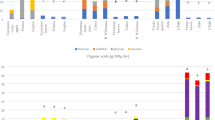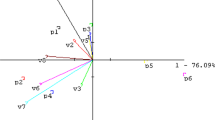Abstract
Objective:
This study was carried out to obtain data about the sugar-, acid- and phenol content of apple cultivars from organic and integrated fruit cultivation, with reference to their role in human health and especially for diet recommendations.
Setting:
Styria (Austria) and Slovenia.
Interventions:
HPLC, Spectral Photometry, organoleptic and olfactory tests.
Results:
The total sugar content of most cultivars from integrated cultivation ranged between 115 and 160 g/kg. Some cultivars from organic growing reached higher values. The acid content of both cultivar types was similar. The phenol content in organically grown cultivars was much higher than that of the ones from integrated cultivation.
Conclusion:
Knowledge of the sugar content is very important for diabetic patients, owing to the assumption of general diet recommendations that 100 g fruit contain 12 g carbohydrates. This applies to most well-known cultivars like Golden Delicious or Gala, but not to most of the regional cultivars. For diabetics, it is necessary to know the carbohydrate content of food precisely, in order to adapt the amount of insulin to the ingestion. So, it is helpful to know the sugar content of each regional cultivar. Moreover, very high levels of phenolic compound in organically grown cultivars, and with it its importance for human health leads to the recommendation to eat regional fruits from organic fruit growing instead of those grown under integrated cultivation.
This is a preview of subscription content, access via your institution
Access options
Subscribe to this journal
Receive 12 print issues and online access
$259.00 per year
only $21.58 per issue
Buy this article
- Purchase on Springer Link
- Instant access to full article PDF
Prices may be subject to local taxes which are calculated during checkout


Similar content being viewed by others
References
Buchter-Weisbrodt H (1999). Mit dem Apfel Gesundheit genieβen, Serie ‘Fit mit Obst’. Schweizerische Zeitschrift für Obst- und Weinbau Wädenswil 4, 109–110.
Buchter-Weisbrodt H, Schöber U (1998). Der Apfel – ein bewährtes Hausmittel neu entdeckt. Trias Verlag Stuttgart.
Chardonnet CO, Charron CS, Sams CE, Conway WS (2003). Chemical changes in the cortical tissue and cell walls of calcium-infiltrated Golden Delicious apples during storage. Postharvest Biol Technol 28, 97–111.
Craig W, Beck L (1999). Phytochemicals: health protective effects. Can J Diet Pract Res Summer 60, 78–84.
Dolenc-Sturm K, Stampar F, Usenik V (1999). Evaluating of some quality parameters of different apricot cultivars using HPLC method. Acta Alimentaria 28, 297–309.
Düsterloh K (2003). Bestimmung des Gesamtphenolgehaltes in Getränken mittels Folin-Ciocalteu-Reagenz Praktikumsmethodensammlung, Universität Hamburg, Institut für Biochemie und Lebensmittelchemie. SOP-Nr 2003.14.
Friedrich G, Neumann D, Vogl M (1986). Physiologie der Obstgehölze vol 2. Auflage Springer Verlag: Berlin-Heidelberg-New York-Tokio.
Gartler B (2003). Genussfrucht Apfel 1. Auflage, Österreichischer Agrarverlag: Leopodsdorf..
Herbinger K, Hofer M, Monschein ST, Fauland K, Keppel H, Veberic R et al. (2004a). Alte Apfelsorten: Gesund und schmackhaft. Besseres Obst 7, 15–16.
Herbinger K, Hofer M, Monschein ST, Fauland K, Keppel H, Veberic R et al. (2004b). Alte Apfelsorten: Vielfältiges Qualitätsspektrum. Besseres Obst 9, 26–28.
Lee KW, Kim YJ, Kim D, Lee HJ, Lee CY (2003). Major phenolics in apple and their contribution to the total antioxidant capacity. J Agric Food Chem 51, 6516–6520.
Mayer B (2001). Untersuchung von Oxidationsprozessen mittels Fluoreszenzspektroskopie Antioxidative Effekte von Bioflavonoiden Dissertation, TU-Graz.
Schirrmacher G, Schempp H (2003). Antioxidative Potential of flavonoid-rich extracts as new quality marker for different apple varieties. J Appl Botany 77, 163–166.
Veberic R, Trobec M, Herbinger K, Hofer M, Grill D, Stampar F (2005). Phenolic compounds in some apple cultivars (Malus domestica Borkh.) of organic and integrated production. J Sci Food Agric 85, 1687–1694.
Acknowledgements
The authors thank Onic Tomas for proof-reading the manuscript and Melanie Hofer for technical support. Sponsorship: This study was financially supported by Interreg III A and Bund-Bundesländer cooperation.
Author information
Authors and Affiliations
Corresponding author
Additional information
Guarantors: K Hecke, K Herbinger, D Grill.
Contributors: R Veberič, M Trobec, H Toplak, F Stampar, H Keppel.
Rights and permissions
About this article
Cite this article
Hecke, K., Herbinger, K., Veberič, R. et al. Sugar-, acid- and phenol contents in apple cultivars from organic and integrated fruit cultivation. Eur J Clin Nutr 60, 1136–1140 (2006). https://doi.org/10.1038/sj.ejcn.1602430
Received:
Revised:
Accepted:
Published:
Issue Date:
DOI: https://doi.org/10.1038/sj.ejcn.1602430
Keywords
This article is cited by
-
Genome-wide association study of individual sugar content in fruit of Japanese pear (Pyrus spp.)
BMC Plant Biology (2021)
-
Characterization of Some Fruit Quality Traits on Apple ‘Kaşel-41’ × ‘Williams Pride’ F1 Population
Erwerbs-Obstbau (2021)
-
Effect of environmental factors on skin pigmentation and taste in three apple cultivars
Acta Physiologiae Plantarum (2020)
-
The effect of green cover within rows on the qualitative and quantitative fruit parameters of full-cropping apple trees
Horticulture, Environment, and Biotechnology (2020)
-
Quality perception throughout the apple fruit chain
Journal of Food Measurement and Characterization (2019)



